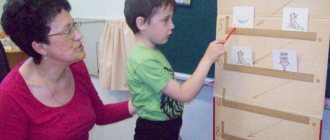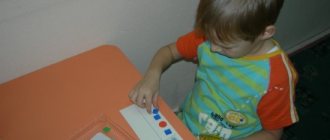What do we mean by speech impairment? The question requires thought, because it is not so easy to decide what is considered speech and at what age speech should be formed in a child. Scientists studying communications have come to the conclusion that many animals can communicate with each other. Dolphins, dogs, and primates have their own language. But speech as a means of verbal communication is accessible only to humans. Of course, provided that he is used to communicating from a very early age. To prevent you from growing up Mowgli, help your child develop speech! Should we sound the alarm if a 2-year-old child cannot construct a coherent sentence or is this normal for his age? But your parents tell you that you are his age... And your friend’s son already tirelessly chats with his parents all day long. How to understand where are individual norms and where are deviations and disorders of speech development? We will talk about this below.
Stages of development and formation of speech in a child
The skills and inclinations of a normally developing child directly depend on his age. But even in infants, experts are able to predict speech disorders in the future based on some signs. If motor development in the first year of life lags behind the norm, this is a possible sign that speech and mental development will also lag behind. We would also like to note that development standards were established in Soviet times and were quite strict. Now, unfortunately, many modern children do not meet them. Children of the new generation speak less and their speech takes longer to develop. The reasons for this are global “gadgetization” and the transition of people to virtual methods of communication.
| Age | Skills |
| up to 6 months |
|
| 6-9 months |
|
| 9 months-1 year |
|
| 1-1.5 years |
|
| 1.5-2 years |
|
| 2-3 years |
|
| 3-5 years |
|
Experts recommend regular examinations to identify delays, if any, as early as possible. One child is one of those who “harnesses slowly and rushes quickly.” He will start speaking later, but within a month he will catch up and surpass his peers. Then consider yourself lucky. But for another child, prolonged silence may hide such gloomy diagnoses as autism spectrum disorder, alalia and others. And it is very important not to miss them and start correction on time.
If you have any doubts about whether your child’s development rate is within the normal range, it is better to visit a specialist. What if he has a general
speech disorder
(general speech underdevelopment - GSD) or delayed speech development (SDD)?
For a child with severe speech impairment
It is often difficult to perceive the world around us positively. He grows up as a gloomy beech, touchy and aggressive, feels insecure, and with age begins to feel his inferiority. You can read more about the symptoms and degrees of speech underdevelopment here. Consult with specialists! Both minor and more significant speech deviations are usually identified in the first few years of life as a result of comprehensive diagnostics.
The spheres and areas of responsibility of specialists in speech problems are distributed as follows:
- Speech therapist
: Consults from 1.5 years old, conducts classes from 2 years old. At the consultation, he makes a final diagnosis, if it is a disease, and refers to a neurologist if there are suspicions of disorders of a corresponding nature; - Speech pathologist
: works with non-speaking children; in case of delays in psycho-speech development and pre-speech diseases (alalia, autism spectrum disorder), it helps to “start” speech and develop other cognitive functions to the level of the age norm.
We are primarily talking about young children. also occur in adults
- due to a brain injury or stroke.
Their correction is carried out by speech therapists and aphasiologists. Sometimes speech impairment in schoolchildren
and adults remains from neglected/undertreated pronunciation defects in childhood.
FIRST SIGNS OF SPEECH IMPAIRMENTS IN A CHILD
According to experts, speech development disorders in children can be identified already in the first weeks of their life. If a child screams weakly, for a long time and monotonously, then you need to carefully monitor his development. Other signs of speech disorders: • By the end of 4 weeks the child is quiet and passive. He does not scream when he wants to eat or feels discomfort; • By the end of 4 months, the baby shows little emotion when parents and loved ones communicate with him. He doesn't smile when mom or dad talk to him tenderly; • 5 months – the child does not pronounce individual sounds or syllables. When parents name an object and point to it, the baby does not try to find it with his eyes. For example, when asked “Where is the light?”, he does not look up at the light bulb; • 7 months – children do not try to attract the attention of their parents by making certain sounds; • 9 months – the baby’s vocabulary has not been replenished with words consisting of the same syllables. For example, ma-ma, pa-pa, give-give, etc.; • 10 months – the child cannot pronounce 8 syllables or sound combinations. In addition, he does not wave his head to confirm the word “no”, nor does he say goodbye by moving his hand. • 12 months – does not understand the meaning of words, but simply repeats them, does not listen to music. He does not understand simple requests, for example, “Give me a spoon”; • 15 months – does not meaningfully pronounce the words “mom”, “dad”; • 19 months – does not understand the meaning of simple words, cannot find parts of the body that adults name; • 29 months – does not understand the meaning of words that indicate size (large-small). If parents notice such signs in their child, then they need to contact a specialist. An otolaryngologist will check the child’s hearing, a neurologist will determine disorders of the central nervous system, a child psychologist, speech pathologist or psychiatrist will assess the state of non-verbal intelligence, and a speech therapist will make a final diagnosis.
Types of speech disorders in children and adults
In speech therapy, several basic typifications are accepted - based on similar manifestations and sources. This helps to understand in which direction to look for the source of the problem and ways to correct speech impairment. Clinical and pedagogical classification
- Rhythm and tempo disorders: Stuttering (a deviation known since time immemorial. According to historians, the ancient Greek orator Demosthenes once suffered from a stutter, but persistently practiced making speeches by stuffing his mouth with small pebbles. Having learned to speak clearly with stones in his mouth, he developed an excellent articulation and self-confidence, thereby getting rid of the disease. Speech therapists still practice this method of correcting speech disorders).
- Dyslalia (in oral speech the child incorrectly pronounces or distorts individual sounds).
- Dysarthria (organs of articulation (lips, tongue) have critical limitations in mobility).
- Rhinolalia (reduced resonance in the nasal cavity).
- Other articulation disorders: polternium, tachylalia, bradyllalia.
- Aphonia (loss of a clear voice, a person speaks in a whisper. Problem with the vocal cords).
- Structural-semantic disorders: alalia (occurs during childbirth when the speech areas of the brain are damaged. At the same time, the child is fine with intelligence and hearing), aphasia (a similar problem. Organic lesions of the areas of the cerebral cortex that are responsible for controlling speech , and the adjacent “subcortex". It differs from alalia in that it is not a congenital phenomenon, but an acquired one - in people who can already speak. Usually occurs as a result of a stroke in adults).
- Dyslexia (difficulty perceiving written text, mixing sounds and words when reading, inability to form letters into ready-made words).
Psychological and pedagogical classification of speech disorders
- violations in the use of communication means stuttering
- other complications
- phonetic-phonemic speech underdevelopment
Causes of speech impairment in children
The deviation can be congenital or acquired, physiological or purely psychological. The choice of correction method directly depends on this. Once upon a time, ideas about the sources of speech anomalies were quite chaotic. Professor Mikhail Khvattsev, one of the pioneers in speech therapy among our compatriots, made a major contribution to the systematization of the causes. He divided them into internal and external and introduced the following classification:
- organic (anatomical-physiological, morphological): organic central (brain lesions);
- organic peripheral (defects of hearing or articulation, cleft palate, dental defects);
- functional (psychogenic - problems with excitation and inhibition in the central nervous system);
Trouble does not come alone; problems on any front will inevitably grow into a whole bunch of accompanying complications. Khvattsev emphasized the close connection between organic and functional causes. If the sensory organs do not work properly, natural reflexes are poorly established. And vice versa, if there are already problems of a functional nature, then the development of organs will also slow down. Like the affected central nervous system, it does not contribute to the development of the periphery.
Depending on the stage at which the basis for speech dysfunctions arose, they are divided into:
- hereditary. Unfortunately, we do not always inherit a strong body from our parents. Children get many troubles “as a gift”, sometimes it is stuttering, various disorders of the speech zones in the cerebral cortex, problems with bite or the wrong number of teeth, defects in the palate, anomalies in the structure of the organs of articulation.
- congenital (intrauterine). Caused by complications during pregnancy. If a woman works in a hazardous industry, delays maternity leave until the last minute or unsuccessfully tries to terminate a pregnancy, if the embryo is forced to drink alcohol, tobacco and strong drugs with the mother, then all this will never benefit the baby. The first trimester is especially important, when the central nervous system is formed in the fetus.
- perinatal (birth) and postnatal (appear soon after birth). They arise due to complications during the very birth of the baby, due to premature birth, as a result of birth injuries, etc.
- others (manifest in the first years of a child’s life and later). Here the root of evil is either psychological, social and everyday factors, or serious illnesses (meningitis and other dangerous infections, diseases of the hearing organs, injuries to the brain and speech organs).
Please note: the risks to which a fetus is exposed at different stages of its development before birth, and an independent person after birth, are not the same. Obvious tips that mothers sometimes neglect:
- during pregnancy, take care of yourself more than usual, avoid injuries, shocks and the use of harmful substances;
- carefully choose a maternity hospital with modern equipment and skilled midwives;
- after birth, do not develop sores, even small ones, remember how vulnerable the fragile organism of a little man who has just come into this world is.
Causes of speech defects
There are quite a few of these factors. They can be either hereditary or acquired.
The causes of speech defects include:
- negative effects on the fetus during pregnancy and childbirth (for example, hypoxia - oxygen starvation);
- heredity;
- birth injuries to the head or brain damage in children under 3 years of age;
- structural features of the speech apparatus (for example, a short hyoid frenulum);
- lack of communication;
- mental trauma, tense family situation;
- an example of incorrect pronunciation on the part of adults.
Prevention of speech disorders. Helping a child at home
To prevent violations and for the general development of speech, constant communication is needed. Otherwise, problems will arise sooner or later, even if there were no medical prerequisites initially. A child learning a language must practice through regular contact with native speakers. And the carriers are you. Communication is an integral part of the education program.
What's useful:
- read together with your child, talk about what you read, illustrate the plot together, discuss the drawings;
- sing songs together;
- listen to the little why, without interrupting, answer his questions about the world around him, teach him to listen to others;
- correct errors in the pronunciation of words and sounds, find the correct analogues for “baby” words and “lisping” (“bobo”, “kaka”).
Mistakes that many people make, but I want to believe you don’t:
- the child’s questions are answered with the general “when you grow up, you’ll know” and “because it ends in U”;
- do little socializing and reading aloud; so that the child is not distracted from his work, they turn on cartoons for the whole day and leave him alone with the TV or computer;
- They repeat with tenderness after the baby everything that he babbles, thereby contributing to the reinforcement of incorrect words and illiterate pronunciation - they impoverish the speech of the future native speaker of the Russian language.
From a “technical” point of view, breathing exercises and tongue exercises are always beneficial. Breathing can be trained using play methods that are interesting to the child: blowing soap bubbles and balloons, learning to play toy flutes and harmonicas. There are standard articulation exercises for practicing various problem sounds, when the tongue, lips and teeth are held for 10-20 seconds in certain positions:
- sound “R” - mouth wide open, tongue at the upper jaw, tapping on the teeth while pronouncing the sound “D”;
- hissing - the lips are extended forward as much as possible, the jaws are closed;
- whistling - the end of the tongue rests against the front teeth of the lower jaw, and the edges against the far teeth of the upper jaw.
When we are talking not about prevention, but about the correction of already established deviations, the work is carried out more deeply, according to individual programs, with the regular participation of a speech therapist. If your child has clear signs of a speech disorder, but you cannot understand the reasons and what to do next, we suggest that you undergo a comprehensive diagnosis of speech disorders at our Center. To make an appointment for an examination and an appointment with a speech therapist, call tel. or use the online registration form on the website e.
CORRECTION OF SPEECH DISORDERS
It is possible to prevent speech disorders from the first days of life; to do this, you need to follow the following recommendations: • Communicate with the baby as often as possible, giving the conversation different emotional tones. Words must be pronounced correctly, smile, frown, show fear, joy, delight, etc.; • Carry out finger exercises regularly; the famous poem “The Magpie-Crow Cooked Porridge” is suitable for this. While reading the poem, you need to ask the baby to repeat certain exercises with his fingers and massage their tips. As the baby grows up, mosaics, construction sets, drawing, modeling, etc. are used to develop fine motor skills. This will all help speed up speech development. From 2.5 years old you can start doing tongue exercises. First, classes are conducted under the supervision of a speech therapist, and then they can be done at home. All movements must be performed in front of a mirror to control them. They are done at a smooth pace, moving from simple elements to more complex ones. To improve the pronunciation of hissing sounds, perform the “Fence” exercise: teeth are closed, lips are extended forward, fixation in this position for 10 seconds. The “Gorka” exercise will help you pronounce whistling sounds well: the mouth is slightly open, the side edges of the tongue rest against the molars, the tip against the front teeth, fixation for 10 - 15 seconds. There are many exercises for different sounds, the main thing is to do them correctly and practice regularly. Breathing exercises will improve the pronunciation of sounds and teach a preschooler to speak correctly and smoothly. There are many exercises that increase the time of oral exhalation from 2 to 8 seconds. In addition, a preschooler needs to be taught to speak through his mouth and nose, and to do this with sound or voice. To do this, you can perform the “Storm” exercise: the child takes a glass of water and a straw, opens his mouth slightly, rests his tongue on his lower teeth, takes the straw, puts it in the glass, and blows so that the water gurgles. At the same time, the cheeks do not puff out and the lips do not move. After regular exercise, the air flow will be stronger and longer. It will also be useful to inflate balloons, soap bubbles, and play games with whistles and musical instruments, such as a harmonica or pipe. The period from 3 to 6 years is ideal for the development of speech in a preschooler, so during this period the following recommendations must be followed: • Speak correctly, without “lisping”; • Place accents correctly; • Speak in simple sentences consisting of 2 – 4 words; • Repeat words over a certain period of time so that the child remembers them and learns to use them; • Correctly change intonation, voice timbre, speech rate; • Gesture when communicating. With dysarthria, dyslalia or motor alalia, pronunciation suffers. This is due to the fact that the child has not learned to control the articulatory organs. To correct defects in sound pronunciation, you need to go through 4 stages: • Stage 1 – preparation for sound production and its automation; • Stage 2 – learning to correctly pronounce a sound in isolated sound; • Stage 3 – development of automatically pronouncing the sound correctly; • Stage 4 – mastering the skill of differentiating sounds by ear, which strengthens the ability to pronounce them correctly. It is important to detect speech disorders in time, as they significantly affect the child’s mental functions. They find it difficult to analyze, synthesize, compare, and generalize. Coordination may also be impaired, speed and dexterity may decrease. Preschoolers have difficulty accepting verbal instructions. Children with speech disorders are withdrawn, touchy, and aggressive. The sooner parents discover speech disorders and contact a speech therapist, the easier it will be to correct them. It is important to conduct a comprehensive diagnosis to identify the causes of the disorder and create an effective treatment plan. With timely, regular lessons, a preschooler will be able to correctly pronounce all sounds, do partial sound analysis, expand his vocabulary, coordinate words in gender, case, number, and even compose complex syntactic structures (dialogue, monologue).






